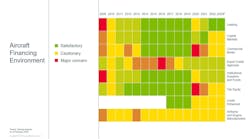China’s investment of billions of dollars in a domestic commercial aviation industry has yet to result in a commercially viable aircraft and is unlikely to do so for the foreseeable future, according to a new RAND Corporation study.
Efforts by the Commercial Aviation Corporation of China (COMAC), the Chinese government’s effort to compete with aircraft manufacturers Boeing and Airbus, to construct new commercial aircraft have been hindered by problems in systems integration. An earlier regional aircraft has yet to obtain Chinese air certification.
COMAC is in the process of designing a narrow-bodied commercial jet, the C919. But by the time the aircraft is ready for production, COMAC will face stiff competition from new Boeing and Airbus models, and will face pricing competition from used Boeing and Airbus aircraft, the study finds.
“The Chinese government sees designing and manufacturing passenger jets as an important indicator of the nation’s advanced technological capabilities,” said Keith Crane, director of the RAND Environment, Energy, and Economic Development Program and co-author of the report. “What they have found is that the commercial aviation sector is a highly competitive market, and that large passenger aircraft are difficult to build to international standards.”
Until recently, production in China’s aircraft manufacturing industry was limited almost exclusively to serving the Chinese military. Consequently, almost all of China’s commercial aircraft have been imported from foreign manufacturers.
The Chinese government has adopted a strategy of first engaging in domestic production and assembly using foreign designs, then developing its own designs with foreign assistance, culminating in development of a commercial aircraft without foreign assistance.
In 2008, the government consolidated its efforts by setting up a new state-owned commercial aircraft manufacturing company, COMAC, to build two domestic aircraft: a regional jet, the ARJ-21, already under development, and a narrow-bodied aircraft, the C919.
The RAND study finds that China’s indigenous commercial aviation manufacturing industry has more than doubled output between 2005 and 2010, while becoming increasingly technologically sophisticated. However, industry output remains a very small share of China’s total industrial output, just 0.17 percent in 2010. Moreover, China’s share of the world export market for commercial aviation products also remains small, just 1.3 percent in 2011.
“Even when these planes are fully realized, they are not likely to be competitive with commercial aircraft now available,” said Scott Harold, a report co-author and an associate political scientist at RAND, a nonprofit research organization. “The Chinese government will then need to face a decision of whether to spend billions more to develop a new round of planes that may or may not be competitive.”
Researchers say that foreign aerospace companies are willing to invest in China because they can cultivate a competitive source for aircraft parts and generate sales to Chinese airlines. However, these companies are wary of losing their intellectual property and technology to the Chinese government, which would in turn use the technology to enhance China’s aerospace industry.
The study offers several key recommendations to trade policy makers in the United States and the European Union to address potential trade issues stemming from Chinese government support for its commercial aviation manufacturing industry, including:
- The United States could engage in bilateral negotiations with the European Union to encourage Airbus and Boeing to reduce the purchase of components as a marketing tool.
- The United States and the European Union could advocate for more transparent tenders for purchases of aircraft by Chinese state-owned airlines.
- The United States and the European Union could monitor the development of Chinese technology and intervene through the World Trade Organization in response to efforts by China to use subsidies to enter American or European Union markets.
“If the Chinese government wishes to fully integrate into the global commercial aviation manufacturing industry, it may wish to consider changing its current policies to create a more-equitable business environment for foreign and Chinese commercial aviation manufacturers,” Crane said.
Researchers suggest that China forego its goal of creating an aerospace “national champion,” and instead focus on general aviation, where it is more likely to succeed building smaller aircraft for private or charter use.
The report, “The Effectiveness of China’s Industrial Policies in Commercial Aviation Manufacturing,” can be found at www.rand.org. Other co-authors are David Yang, Samuel K. Berkowitz and Xiao Wang.
The report was funded by RAND donors and conducted within the RAND Environment, Energy, and Economic Development Program, part of RAND Justice, Infrastructure, and Environment division. The program addresses topics relating to environmental quality and regulation, water and energy resources and systems, climate, natural hazards and disasters, and economic development, both domestically and internationally.

